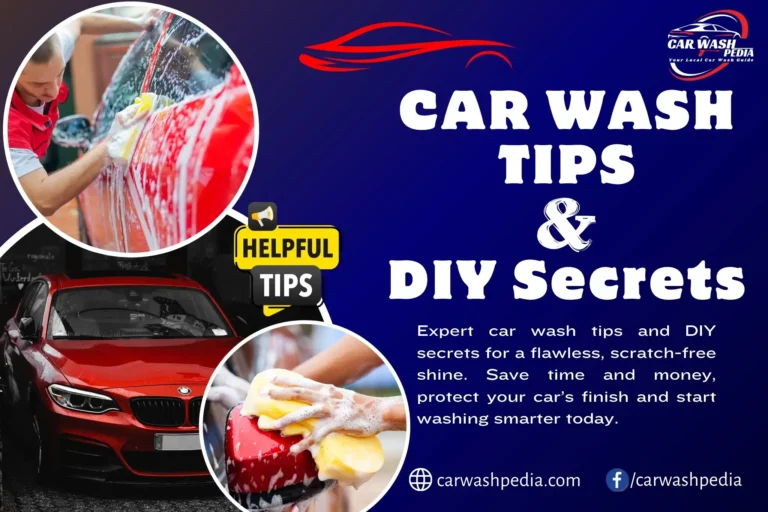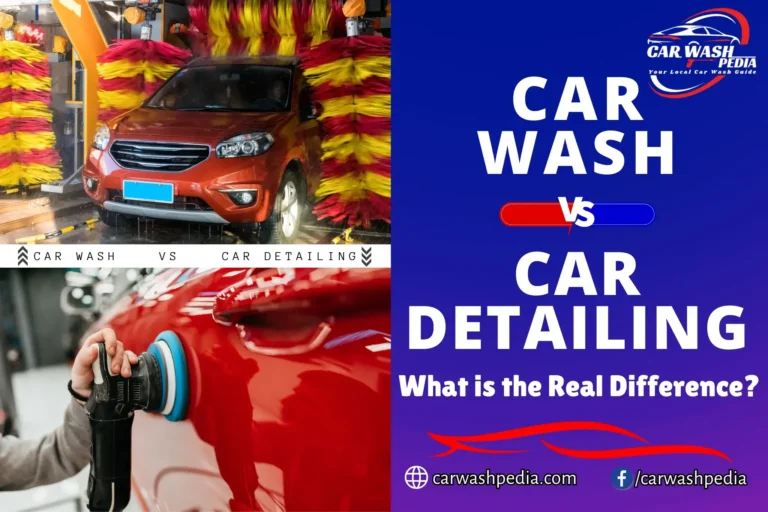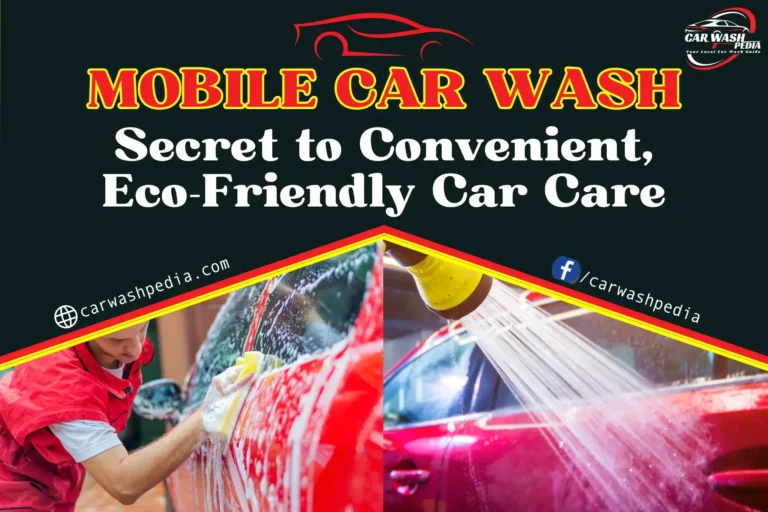11 Car Wash and Detailing Tips You Would Love to Know
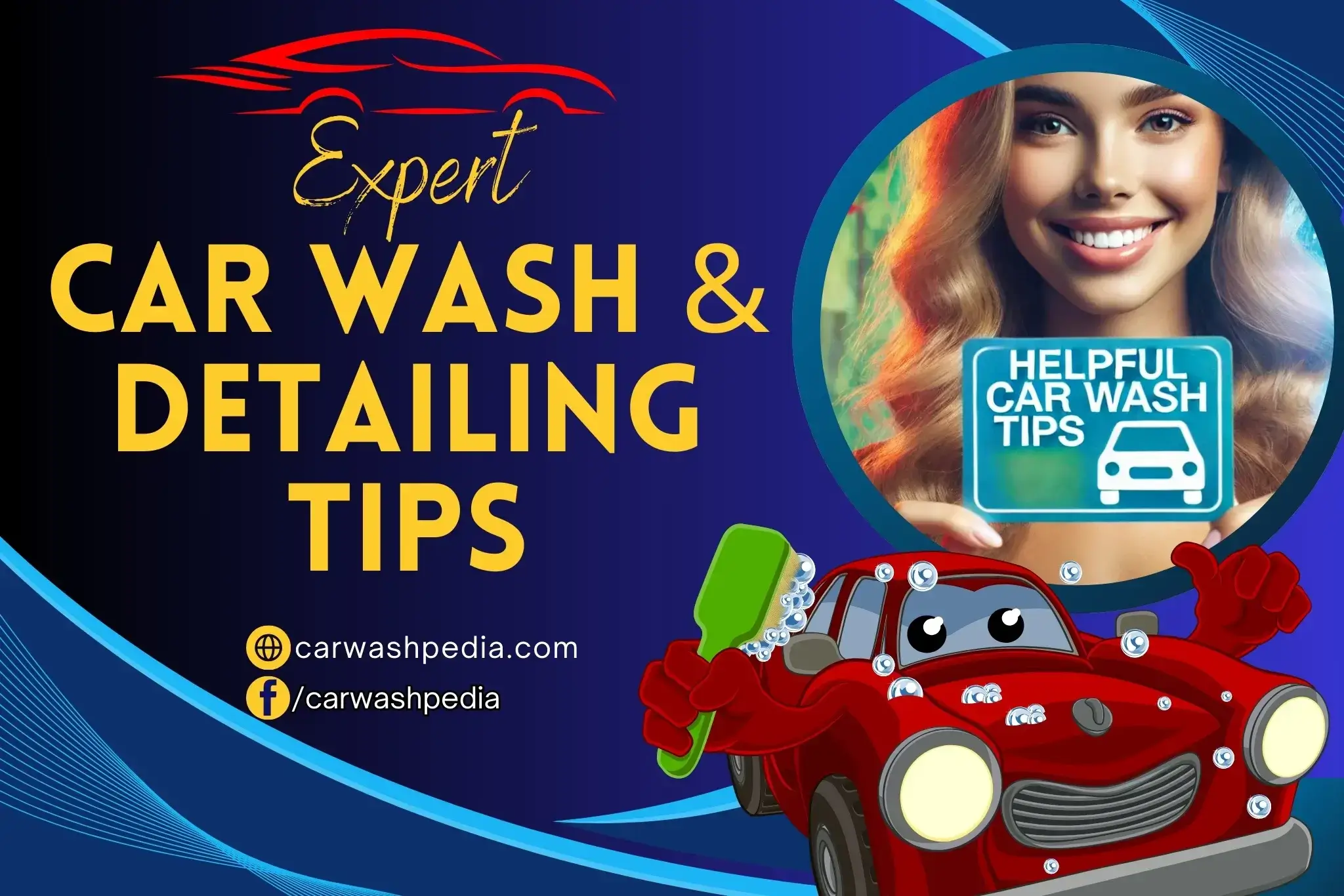
Introduction to Car Wash and Detailing Tips
Why Proper Car Care is Important
Maintaining the cleanliness of your vehicle extends beyond aesthetic appeal. Regular car washing and detailing protect the paint, remove contaminants, and help maintain resale value. Dirt, road salt, and grime can damage your car’s finish over time. A well-maintained vehicle not only looks sharp but also lasts longer. We will explore some expert car wash and detailing tips going forward.
How These Car Wash and Detailing Tips Help
Many car owners struggle to keep their vehicles looking spotless. Whether you prefer a basic car wash or a complete car detail, using the right techniques makes a big difference. These expert tips will help you:
- Get a streak-free clean windshield and windows.
- Use high-quality cleaning products for a showroom shine.
- Avoid scratches and swirls with proper hand-wash methods.
- Keep your car’s interior clean and fresh.
Challenges for Car Owners in the USA
Weather and road conditions in the USA vary by region, and so do car cleaning needs.
- Northern states: Snow and road salt in winter require frequent washes to prevent rust.
- Coastal areas: Salt air can damage the paint, making automotive detailing essential.
- Urban environments: Pollution and dust require routine hand washing to keep the car looking new.
This guide covers car wash and detailing tips that work for all conditions, helping car owners keep their vehicles in top shape.
Why Car Wash and Detailing Tips Matter
Maintaining a clean vehicle goes beyond mere esthetics. A well-maintained vehicle lasts longer, holds its value, and ensures a safer driving experience. Whether you wash your car at home or take it to a professional auto detailing service, following the right steps can prevent long-term damage and keep your vehicle looking its best.
Preserve Your Investment
A car is a significant investment, and regular maintenance helps protect it.
- Maintains the Paint Finish – Dirt, dust, and road grime can cause micro-abrasions on automotive paint. Frequent washing and waxing with high-quality car cleaning products help maintain a smooth finish.
- Prevents Rust and Corrosion – Road salt, rain, and mud can lead to rust, especially in regions with harsh winters. Rinsing off these elements with clean water and using a car wash soap can prevent corrosion.
- Protects Interior Surfaces – Dust, food crumbs, and stains can damage your car’s interior. Regular interior detailing keeps seats, dashboards, and carpets in top shape.
Improve Safety and Visibility
A clean car is not just about looks, it enhances safety.
- Clear Windshields and Windows – A dirty windshield or side windows can reduce visibility. Using a window cleaner removes smudges, streaks, and water spots.
- Better Headlight Performance – Dirt and grime can dull headlights, reducing their brightness at night. Cleaning headlights with automotive glass products improves visibility.
- Prevent Slippery Surfaces – A greasy steering wheel or dusty dashboard can be distracting. Wiping them down with a dashboard protectant spray ensures a secure grip while driving.
By following proper car wash and detailing tips, you can maintain your car’s value, enhance safety, and keep your ride looking great for years to come.
Car Wash and Detailing Tip 1: Pre-Wash Preparation
A proper car wash starts with good preparation. Taking the time to set up everything before washing your vehicle helps prevent scratches, streaks, and other damage. This step ensures that your car wash and detailing process is effective and safe for your vehicle’s paint.
Gather Quality Materials
Using the right tools and products makes a big difference in the results of your car wash. Cheap or improper materials can leave swirl marks and scratches, reducing the shine of your car.
- Microfiber towels and car wash mitts – These prevent scratches and trap dirt effectively. Unlike regular sponges, microfiber is soft and non-abrasive.
- pH-neutral car wash soap – Avoid dish soap or household cleaners, as they strip away wax and harm the paint.
- Two buckets for washing and rinsing – This method prevents dirt from being reintroduced to your car’s surface.
- Soft bristle brushes – These are ideal for cleaning wheels and hard-to-reach areas.
- Car detailing products – A good wax or sealant helps protect your car’s paint after washing.
Choose the Right Environment
Where and when you wash your car plays an important role in preventing water spots and streaks.
- Wash in a shaded area – Direct sunlight causes soap and water to dry quickly, leaving behind spots and streaks.
- Avoid washing on windy days – Wind can blow dust and dirt onto the car while you are cleaning.
- Use a level surface – Washing on an incline can cause water to pool and leave uneven drying marks.
By taking these simple but essential steps, you can make sure your car wash and detailing session is smooth, effective, and safe for your vehicle’s surface.
Car Wash and Detailing Tip 2: Use the Two-Bucket Method
The two-bucket method is one of the best techniques for a scratch-free car wash. It helps prevent dirt and grime from being reintroduced to the surface of your car, keeping your paint in top condition. Many professional car detailing experts recommend this approach for a safe and effective wash.
Minimize Dirt Transfer
A major mistake people make during a hand car wash is using the same bucket for both washing and rinsing. This leads to dirt particles mixing with clean soapy water, which can scratch the car’s paint. The two-bucket method solves this problem.
- One bucket for soapy water – This holds the car wash solution that lifts dirt off the surface.
- One bucket for rinsing – This bucket contains clean water to rinse out the wash mitt after each section, preventing dirt from going back onto the car.
- Grit guards help – Placing a grit guard at the bottom of each bucket traps dirt, keeping it from being reintroduced to the mitt.
By separating the washing and rinsing process, you avoid swirling dirt across the car’s paint, reducing the chances of fine scratches and swirls.
Prevent Scratches
Scratches often appear after car washing due to improper techniques. The two-bucket method minimizes the risk of paint damage by keeping dirt away from the cleaning process.
- Reduces the risk of rubbing debris into the paint – Instead of rubbing the dirt back onto the surface, rinsing in a separate bucket keeps the wash mitt clean.
- Prevents swirl marks – Using one dirty bucket leads to circular scratches, which dull the car’s shine over time.
- Works for all types of vehicles – Whether you have a ceramic-coated car, a black vehicle prone to swirl marks, or a classic car with delicate paint, this method ensures a safer wash.
Using the two-bucket wash technique helps maintain your car’s showroom shine while protecting its paintwork. It is an easy but highly effective way to make sure your car detailing routine is safe, professional, and streak-free.
Car Wash and Detailing Tip 3: Invest in Quality Cleaning Products
Using high-quality car cleaning products is essential for achieving a streak-free shine while protecting your vehicle’s paint and interior. Many cheap or household cleaners contain harsh chemicals that can strip wax, damage paint, and leave streaks on windows. Investing in automotive-specific products ensures better results and long-term protection.
Automotive-Specific Cleaners
Not all cleaning products are safe for cars. Many household glass cleaners contain ammonia, which can damage tinted windows and leave behind streaks. Choosing automotive-specific cleaners prevents these issues and delivers professional-grade results.
- Use ammonia-free car glass cleaners – Specially formulated car glass cleaning solutions keep windows clear without harming window tint.
- Pick pH-balanced car wash soaps – Regular dish soap strips protective wax layers, while pH-balanced shampoos remove dirt without harming the paint.
- Use tire and wheel cleaners – Brake dust and road grime need strong but safe wheel cleaning solutions to maintain a clean finish.
Investing in high-quality cleaning products ensures your car stays spotless without unnecessary wear.
Effective Scratch Removal Products
Scratches often appear after regular washing due to improper techniques or low-quality products. Choosing the right scratch removal solutions helps maintain a smooth, glossy finish.
- Use a quality scratch remover – Products like Meguiar’s Ultimate Compound or Turtle Wax Scratch Repair work well for minor imperfections.
- Polishing compounds for deep shine – Using auto glass polish or car paint scratch solutions can restore shine and smooth out imperfections.
- Microfiber towels for a swirl-free finish – Always use soft microfiber towels to prevent scratches while drying or buffing.
Investing in professional-grade car cleaning products helps maintain your vehicle’s appearance and value. Automotive-safe cleaners, proper scratch removers, and high-quality towels are worth the investment to keep your car looking showroom-new for years to come.
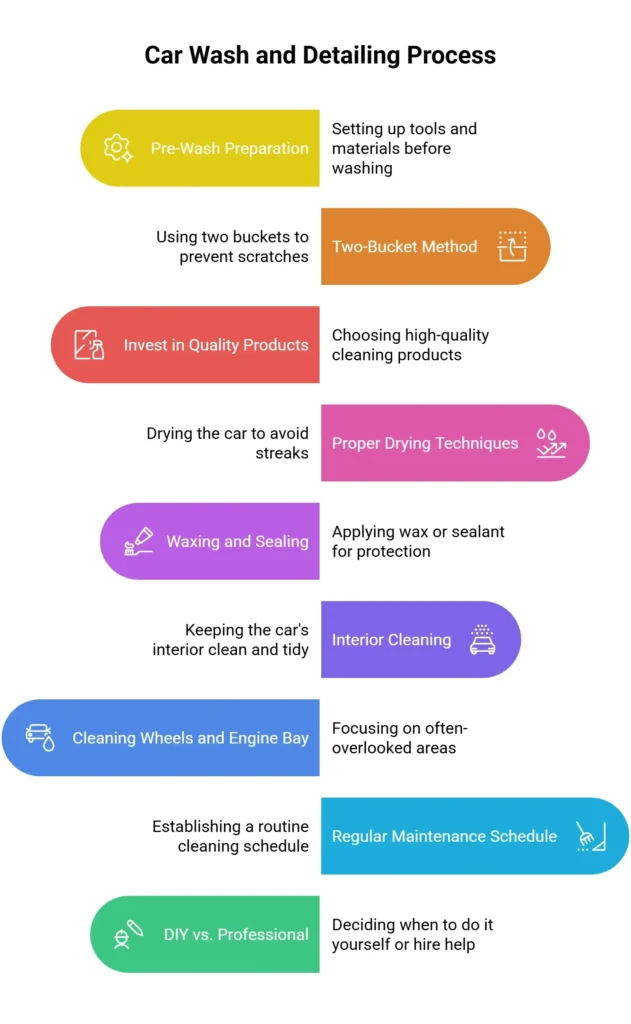
Car Wash and Detailing Tip 4: Master Proper Drying Techniques
Drying your car correctly is just as important as washing it. If not done properly, leftover water droplets can lead to streaks, water spots, and even mineral deposits that dull your car’s shine. Mastering the right drying techniques helps maintain a spotless, streak-free finish and preserves your vehicle’s paint and glass surfaces.
Avoid Water Spots
Leaving water on your car after a wash can cause unsightly water spots that are difficult to remove. Using the right drying tools prevents these marks and ensures a clean, polished look.
- Use microfiber towels – These soft, absorbent towels prevent scratches and swirl marks while soaking up excess water.
- Opt for an air dryer or leaf blower – Using compressed air or a high-powered blower removes water from hard-to-reach areas like mirrors, door handles, and emblems.
- Dry immediately after washing – Do not let water air-dry in direct sunlight, as this increases the chances of streaking and water spots.
Techniques for Best Results
Using the right drying technique makes a noticeable difference in your car’s appearance. Following a structured method ensures even drying and prevents damage.
- Work from top to bottom – Start with the roof, windows, and hood, then move down to the doors and bumpers. This prevents dirty water from dripping onto already dried areas.
- Use the pat-dry method – Instead of rubbing the surface, gently press and lift the microfiber towel to absorb water without causing streaks.
- Pay attention to crevices – Water tends to collect around badges, side mirrors, and trim. Use a detailing brush or air dryer to remove trapped moisture.
Proper drying techniques help maintain a streak-free shine and prevent hard water stains that can dull your car’s look over time. Investing in high-quality microfiber towels and using blowers for detailed drying ensures your vehicle stays in pristine condition after every wash.
Car Wash and Detailing Tip 5: Waxing and Sealing Your Car
After washing and drying your car, applying wax or sealant is the next step to keep your vehicle looking brand new. Waxing enhances shine, repels dirt, and provides a protective barrier against the elements. If you want even longer-lasting protection, ceramic coatings are a great option, especially in the USA climate, where UV rays, rain, and road salt can damage your car’s finish.
Restore Car Shine
A high-quality car wax brings out the depth and gloss of your car’s paint while adding a layer of protection. Sealants and ceramic coatings go even further by providing long-lasting durability.
- Apply a premium car wax – Carnauba and synthetic waxes both protect your car’s clear coat while enhancing shine.
- Use a paint sealant – Unlike wax, sealants last longer and provide a stronger shield against UV rays, acid rain, and pollutants.
- Buff for a streak-free finish – Use a microfiber applicator to apply wax in thin, even layers and buff it out for a high-gloss effect.
Long-Lasting Protection
While traditional wax needs reapplication every few months, ceramic coatings provide long-term defense against harsh environmental conditions.
- Shield against UV damage – The sun’s rays can fade and oxidize car paint. A ceramic coating acts as a sunscreen for your car, preventing sun damage.
- Repel water and dirt – Hydrophobic properties make water bead off the surface, reducing water spots and dirt buildup.
- Ideal for extreme weather – If you live in a snow-prone or high-humidity region, a ceramic coating protects against road salt, rain, and contaminants.
Waxing or sealing your car is an essential step in car detailing that restores shine and protects the paint from damage. If you prefer a DIY method, car wax is a great choice. But for long-term durability, a ceramic coating offers advanced protection that can last for years with minimal maintenance.
Car Wash and Detailing Tip 6: Interior Cleaning Best Practices
Maintaining a tidy interior is just as crucial as keeping your exterior spotless. Dust, dirt, and grime can accumulate inside your car, making it look dull and uninviting. Regular interior cleaning keeps your vehicle fresh, prevents wear and tear, and enhances your driving experience. Follow these best practices to maintain a pristine car interior.
Clean Windshield and Windows Inside
Your car’s windshield and side windows collect fingerprints, smudges, and dust over time, reducing visibility. Using the right cleaning products ensures streak-free clarity.
- Use an automotive glass cleaner – Choose a streak-free, ammonia-free window cleaner to avoid damaging tinted windows.
- Spray onto a microfiber cloth, not the glass – This prevents overspray from dripping onto the dashboard or seats.
- Wipe in a circular motion and finish with a dry wipe – This technique removes haze and leaves a crystal-clear surface.
Detail Upholstery and Dashboard
The seats, dashboard, and carpets accumulate dust, crumbs, and stains from daily use. A deep clean prevents fading, cracking, and bad odors.
- Vacuum all surfaces – Use a handheld or shop vacuum with a crevice tool to remove dirt from carpets, seats, and hard-to-reach areas.
- Use the right cleaner for each surface – Choose a vinyl cleaner for dashboards, leather conditioner for leather seats, and fabric cleaner for cloth upholstery.
- Do not forget the air vents – Dust in the AC vents can affect air quality. Use a small detailing brush or compressed air to clean them.
Keeping your car’s interior spotless improves its overall look and feel. Regularly cleaning windows, upholstery, and the dashboard prevents dust buildup and wear. By following these interior detailing best practices, you will enjoy a clean, fresh-smelling, and comfortable ride every time you drive.
Car Wash and Detailing Tip 7: Cleaning Wheels and Engine Bay
Many car owners focus on washing the exterior body and windows, but wheels and the engine bay often get overlooked. These areas collect the most dirt, grease, and grime, affecting both the appearance and performance of the vehicle. Regular cleaning ensures that your car not only looks great but also runs smoothly.
Do Not Neglect Critical Areas
The wheels and engine bay need specific cleaning techniques and products to avoid damage. Using the wrong cleaners can strip away protective coatings or cause corrosion.
- Use a dedicated wheel cleaner – Brake dust, road salt, and dirt build up quickly on wheels. Choose a pH-balanced wheel cleaner that removes grime without harming the finish.
- Scrub with a wheel brush – A soft-bristle brush reaches between spokes and around lug nuts, removing stubborn dirt.
- Rinse thoroughly – Leftover cleaner can damage wheel coatings. A strong rinse ensures all residue is removed.
- For the engine bay, use a degreaser – The engine collects oil, dust, and road grime, so a safe degreaser helps break down buildup without harming components.
- Cover electrical parts before spraying – To protect sensitive areas, cover battery terminals, alternators, and sensors with plastic bags before spraying any cleaner.
Maintain a Uniform Look
A clean car should look great from every angle, including wheels and under the hood. Dirt on rims, tires, or engine parts can make a freshly washed car look incomplete.
- Shine the tires – After washing, apply a tire dressing to give a deep black finish. This protects against cracking and fading.
- Detail the engine for a showroom look – After cleaning and drying, apply a light coat of rubber or plastic protectant to hoses and plastic components to restore shine.
- Ensure every visible part is spotless – A well-detailed car includes clean wheels and an engine bay, making the entire vehicle look professionally maintained.
Regularly cleaning the wheels and engine bay not only improves your car’s appearance but also extends its lifespan. Using proper cleaners and techniques prevents damage and keeps all parts of your vehicle in top condition. By paying attention to these often-neglected areas, you ensure a complete and polished look every time you wash your car.
Car Wash and Detailing Tip 8: Establish a Regular Maintenance Schedule
Keeping your car clean and well-maintained is not just about looks. A consistent car wash and detailing schedule helps protect the paint, interior, and overall condition of your vehicle. Whether you drive daily in city traffic, live in a dusty area, or face harsh winter conditions, sticking to a routine can prevent long-term damage and maintain your car’s value.
Routine Washing and Detailing
The best maintenance schedule depends on your location, driving frequency, and weather conditions.
- Wash your car every two weeks – This prevents dirt, road salt, and pollutants from building up and damaging the paint.
- Detail your car every 3 to 6 months – Regular deep cleaning, waxing, and interior detailing keep the car looking and feeling fresh.
- Adjust based on driving conditions – If you drive in areas with heavy dust, rain, or snow, you may need to wash your car more frequently.
- Use the right products for lasting protection – Quality automotive soaps, waxes, and sealants help protect the exterior from fading and damage.
Prevent Build-Up Over Time
Dirt, grime, and contaminants can wear down your car’s finish if left untreated. Sticking to a routine keeps your car looking its best and prevents costly repairs in the long run.
- Avoid letting dirt settle – Road grime, tree sap, and bird droppings can eat into the paint if not cleaned off promptly.
- Maintain the interior – Regular vacuuming and wiping keep dust and stains from setting in.
- Protect against seasonal damage – Winter road salt, summer UV rays, and autumn debris all take a toll on your car’s exterior. Applying wax or ceramic coating adds an extra layer of protection.
- Check for minor damage – A routine wash allows you to spot small scratches, chips, or rust early before they become bigger issues.
A regular car wash and detailing schedule helps maintain your vehicle’s shine, cleanliness, and resale value. By washing and detailing on time, using quality products, and protecting your car from seasonal hazards, you can keep your vehicle looking like new for years to come.
Car Wash and Detailing Tip 9: Know When to Go DIY vs. Professional
Not every car wash or detailing task requires a professional touch. Some maintenance can be done at home, while more complex issues may need expert attention. Knowing when to DIY and when to seek professional help saves time and money while keeping your car in top shape.
DIY Car Scratch Removal Techniques
Handling minor scratches and routine detailing at home can be cost-effective and convenient.
- Light surface scratches – If scratches only affect the clear coat, you can buff them out using a scratch removal kit.
- Polishing and waxing – Regular waxing protects the paint and adds shine. A good polish removes swirl marks for a smooth finish.
- Interior detailing – Cleaning your dashboard, seats, and carpets is easy with DIY detailing products. Using a high-quality vacuum and fabric protectant can keep your interior looking fresh.
- Headlight restoration – Cloudy headlights can be polished and restored at home using headlight cleaning kits for better nighttime visibility.
Signs You Need Professional Help
Some detailing jobs require expert tools and techniques that DIY methods cannot fix.
- Deep scratches and paint damage – If a scratch goes beyond the clear coat and exposes the paint or metal, a professional paint correction service may be necessary.
- Extensive oxidation or fading – If your car’s paint looks dull or discolored, a paint restoration service can bring back its original shine.
- Severe interior stains or odors – Stubborn stains on leather seats, carpets, or headliners may need a steam cleaning or deep shampooing service.
- Ceramic coating application – Applying ceramic coatings requires skill for proper bonding and long-lasting protection.
If you enjoy keeping your car clean, DIY methods can help with basic maintenance and small touch-ups. However, for serious scratches, deep stains, or major paint corrections, a professional detailer can ensure the best results. Choosing the right approach helps maintain your car’s value and appearance for years to come.
Car Wash and Detailing Tip 10: Explore Additional Expert Advice
Car detailing constantly evolves, with new products and techniques improving the way scratches, stains, and paint imperfections are handled. Learning advanced methods and staying informed on the latest car care solutions can help keep your vehicle looking pristine.
Advanced Scratch Repair Techniques
While basic scratch removers work for minor imperfections, advanced methods can restore deeper scratches and protect the paint from further damage.
- Nano sparkling cloths – These innovative cloths use micro-abrasive technology to buff out minor scratches without damaging the paint. They are easy to use and great for quick touch-ups.
- Professional-grade scratch removers – Products like Meguiar’s Ultimate Compound or Turtle Wax Scratch Repair & Renew are designed to remove swirl marks, oxidation, and surface scratches effectively.
- Paint correction techniques – For more serious defects, using a dual-action polisher with a high-quality cutting compound can restore paint clarity and eliminate scratches.
Stay Updated on New Products
The automotive detailing industry is always introducing better, more effective products that make car washing and scratch removal easier.
- Ceramic-based scratch protection – Many new sealants and waxes now include ceramic properties, which add durability and enhance shine.
- Eco-friendly car wash solutions – Waterless car wash sprays and biodegradable cleaners provide a safe and effective way to clean your car while being environmentally responsible.
- Self-healing paint protection films – These high-tech films are applied to the car’s surface and automatically repair minor scratches when exposed to heat.
Learning advanced car detailing techniques and staying updated on new products can help maintain your vehicle’s showroom shine. Whether you use DIY solutions or seek professional treatments, keeping up with the latest car care innovations ensures your car always looks its best.
Car Wash and Detailing Tip 11: Tip for a Scratch-Free Car Wash
Keeping your car free from scratches requires proper washing techniques and proactive protection. Many paint imperfections occur due to incorrect washing, drying, and maintenance. By following best practices, you can keep your car’s surface smooth and flawless for years.
Tips for a Scratch-Free Car Wash
Using the right tools and methods prevents swirl marks, scratches, and damage to your car’s paint.
- Rinse Before Washing – Always rinse your car thoroughly to remove loose dirt and debris. This prevents grit from rubbing against the surface when washing.
- Use a Two-Bucket Method – One bucket should hold clean, soapy water, and the other should be for rinsing your wash mitt. This prevents dirt from transferring back onto the car’s surface.
- Choose a Soft Wash Mitt – A high-quality microfiber mitt is gentler on paint than sponges, which can trap dirt and cause fine scratches.
- Wash in Straight Lines – Avoid circular motions while washing, as they can create swirl marks over time. Instead, wash in straight lines to minimize damage.
- Dry with a Microfiber Cloth – Using a soft microfiber towel ensures that moisture is absorbed without streaks or scratches.
Proactive Measures to Prevent Future Scratches
Beyond proper washing, adding protective layers can help prevent scratches and keep your car looking new.
- Apply a Ceramic Coating – A ceramic coating forms a durable protective layer that repels dirt, water, and contaminants, reducing the chances of scratches.
- Wax Regularly – Using car wax at least every three months adds a smooth barrier between the paint and external elements.
- Use a Car Cover – If you park outside, a car cover protects against dust, debris, and accidental scratches from the environment.
- Inspect and Maintain Paintwork – Regularly check your car’s surface for small imperfections and address them immediately with a scratch remover or polishing compound.
Preventing scratches is easier than fixing them. By following proper washing techniques and using protective measures, you can keep your car’s paint in top condition. A scratch-free finish not only looks great but also helps maintain your car’s value over time.
Concluding Words
A clean and well-maintained car not only looks great but also lasts longer. By following the right car wash and detailing techniques, you can keep your vehicle looking brand new while also protecting its paint and interior surfaces.
Recap Key Car Wash and Detailing Tips
Throughout this guide, we have covered essential car wash and detailing tips to help you maintain a spotless, scratch-free vehicle. Here are the key takeaways:
- Pre-Wash Preparation – Gather quality cleaning products and choose the right environment for washing.
- Use the Two-Bucket Method – This technique minimizes dirt transfer and prevents scratches.
- Invest in Quality Cleaning Products – Using automotive-specific cleaners ensures better protection and results.
- Master Proper Drying Techniques – Prevent water spots by using microfiber towels and drying in sections.
- Apply Wax or Sealant – Protect your car’s paint and enhance its shine.
- Clean the Interior Regularly – Use interior-safe cleaners to keep the dashboard, upholstery, and windows spotless.
- Detail Wheels and Engine Bay – Do not overlook these areas, as they accumulate dirt faster.
- Follow a Maintenance Schedule – Routine washing and detailing prevent long-term damage.
- Know When to Go DIY vs. Professional – Minor scratches can be fixed at home, but deep ones need expert attention.
- Explore Expert Advice – Stay updated with the latest scratch removal products and detailing techniques.
- Follow a Scratch-Free Car Wash Routine – Proper washing, rinsing, and drying methods ensure a flawless finish.
Encourage Routine Car Care
Regular car washing and detailing is not just about keeping your vehicle clean, it also protects its value. In the USA, factors like harsh weather, road salt, and urban pollution can take a toll on a car’s paint and interior. Sticking to a consistent cleaning and maintenance routine ensures your car stays in top condition year-round.
Do you have your own car wash and detailing tips that have worked well for you? Share them in the comments! Your experience could help other car enthusiasts looking for effective cleaning and detailing solutions.
If you found this guide helpful, consider sharing it with friends, family, and fellow car owners who want to keep their vehicles looking brand new. For more expert car care advice, explore our latest car detailing guides and tips.
